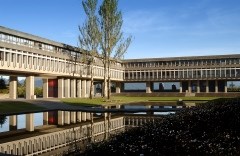Simon Fraser University is being criticized for axing two programs designed to prepare indigenous students for entry into university.
Vice-president academic and provost Peter Keller announced last Wednesday he was shutting down the aboriginal university transition programs (the aboriginal university pre-health program and the aboriginal university prep program) even though funding for the program wasn’t set to expire until the end of next academic year.
“It’s absurd,” former student Herb Varley told the NOW.
Varley, who finished the program just a couple of weeks ago and now plans to pursue an undergraduate degree, said the program helped him make the move from self-taught, lifelong learner to university student after a bad high school experience and 13 years out of school.
“It would have been too much of a culture shock just to be thrown into my first year of undergrad,” the 33-year-old community leader and Downtown Eastside activist said.
As the son of a residential school survivor, he said he had been leery about formalized learning institutions, but the program helped bridge the gap.
“The teachers were a little bit more flexible and understanding about where I came from,” Varley said.
“These programs contribute a huge amount to a person’s ability to succeed,” said Natalie Knight, an instructor in the aboriginal university prep program.
Knight said the university announced the cuts suddenly, without warning her or the program’s manager.
Since funding was set to expire after the end of next school year, she said staff had been in the process of an internal review to find ways to maintain the programs, which have enrolled a total of 80 students since 2011.
Now that they’ve been cancelled, Knight and Varley question where the money earmarked for them is going to be spent.
“What do they do with that money? Are they going to siphon it into a f***ing painting or totem pole?” said Varley, referencing the Squamish welcome figure unveiled at the Burnaby campus with much ceremony last month.
“There’s a difference between rhetoric and action,” Varley said. “Those totem poles are more just photo ops and these big visual spectacles to make it seem as if the relationship between these Canadian institutions and indigenous people are all hunky dory and fine. But, as the cutting of the program shows very clearly, all of those are just visuals at the end of the day.”
Keller, however, said the program was being cut because it wasn’t attracting a sustainable number of students.
The aboriginal university pre-health program has, in fact, already been dormant for two years, he said.
SFU is “absolutely” committed to offering another bridging or pathways program for indigenous students in the future, according to Keller, but the university has decided to take time out to re-envision it and get it right.
“Could we have done that while still allowing students to stay in the program?” Keller said. “That was the big question, and the answer to my mind was clearly no because we just weren’t attracting enough students to make a cohort-based program work.”
The money budgeted for the program next year will be carried forward or be invested in the consultation and re-envisioning process, he said.
Keller said he was in the process of appointing someone to lead the work, but did not provide a timeline or details about what the new transition program would look like.
“Those conversations take time because I have to make sure I’m consulting with all the right communities, even just to make sure that I’ve got the right players at the table,” Keller said.
The VP maintained the university has tried hard to make the program work, and the decision to cut the program was not a question of resources.
Knight, however, disagreed.
She argued the university could increase enrolment in the programs by putting more resources into recruitment and waiving the $2,970 program tuition fee.
She also argued it should not be cut without anything to replace it.
“Without it, we lose something that we don’t have in place anywhere else in the Lower Mainland,” she said.



